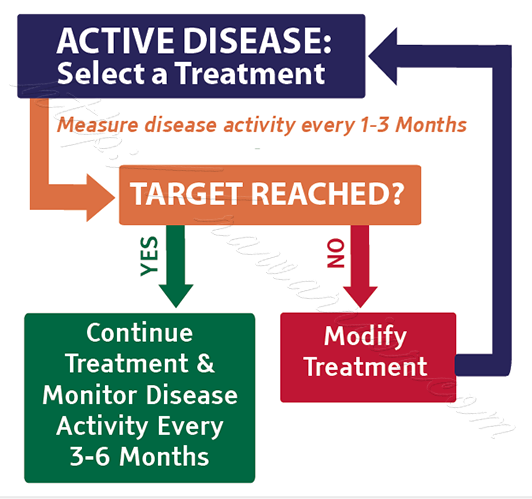Rheumatoid Arthritis (RA) Treat to Target
The treat to target (T2T) approach involves defining a treatment goal or “target” and modifying the therapy if the target is not reached.
Treating to a target of remission or low disease activity
 Treat to target (T2T) is an approach to treating Rheumatoid Arthritis / Rheumatoid Disease (RD) that combines aggressive or intensive treatment with disease modifying antirheumatic drugs (DMARDs) and regular monitoring of disease activity (DA). The goal of treat to target is to achieve a “target” of clinical remission or low disease activity (LDA).
Treat to target (T2T) is an approach to treating Rheumatoid Arthritis / Rheumatoid Disease (RD) that combines aggressive or intensive treatment with disease modifying antirheumatic drugs (DMARDs) and regular monitoring of disease activity (DA). The goal of treat to target is to achieve a “target” of clinical remission or low disease activity (LDA).
Experts agree the ideal target in RD treatment is remission, defined as “the absence of signs and symptoms of significant inflammatory disease activity.”[1] However, in some circumstances, LDA is chosen as an alternate target. There are various definitions of remission (or LDA) according to various DA measures, and unfortunately, clinical remission or LDA does not mean that all symptoms are necessarily eliminated. Research will continue to improve both treatment strategies and medications, so that hopefully complete remission will become more realistic for everyone with Rheumatoid Disease.
How does Treat to target work in Rheumatoid Disease?

With T2T, DA is measured; and if it is not improved, the treatment plan is adjusted. An expert international task force recommended that drug therapy be adjusted at least every 3 months until the desired target is reached.[1] Specific guidelines have been recommended for rheumatologists concerning when to use each type of medicine. Until the target is reached, doctors might recommend one of the following changes:
- Increasing a medication dose
- Adding a new medication
- Substituting a new medication for a previous medication
T2T can result in lower disease activity levels for people with RD, which can mean less pain, disability, and damage.
According to the TICORA study, which pioneered T2T in RD, striving for a specific improvement target improves outcomes.[2] One day, a cure for RD will be found to address all of the problems the disease creates, but today, intensive therapy with thorough monitoring produces the best outcomes. “The concept of achieving tight control of RA and treating to target has been well established and utilizes early diagnosis, aggressive treatment, and regular monitoring, leading to positive outcomes in a significant number of patients with RA who achieve current treatment goals of low levels of disease activity or clinical remission.”[3]
Which methods of measuring disease activity are used in T2T?
Patient reported outcome measures are used in combination with swollen and tender joint counts and blood tests to create instruments such as the CDAI (Clinical Disease Activity Index), SDAI (Simplified Disease Activity Index), DAS28 (Disease Activity Score in 28 Joints), and RAPID3 (Routine Assessment of Patient Index Data 3). Whichever instrument your doctor uses, what’s most important for PRD to know is that measuring DA is a valuable part of rheumatology care.
Various imaging tests are also used to help assess DA, such as musculoskeletal ultrasound, MRI, or nuclear bone scan. However, these tests do not provide a clear DA score that is needed in T2T. Disease activity is measured more frequently (often monthly) for patients with high or moderate disease activity. DA is measured less frequently, such as every 3 to 6 months, for patients in sustained remission or low DA.[1]
NOTE: The Rheumatoid Patient Foundation has brochures available on Treat to Target and other topics – click here to view.
Recommended reading
- Sustained Rheumatoid Arthritis Remission Is Rare
- Accurately Measuring Rheumatoid Disease Activity
- New Rheumatoid Arthritis Remission Criteria
- 10 Reasons We Might Want a Musculoskeletal Ultrasound (MSUS) of a Joint
- 22 posts about measuring disease activity
1 Smolen JS, Aletaha D, Bijlsma JW, et al. Treating rheumatoid arthritis to target: recommendations of an international task force [published correction appears in Ann Rheum Dis. 2011;70:1519]. Ann Rheum Dis. 2010;69:631-637. Available from: http://ard.bmj.com/content/69/4/631.long




I have had RA for 20 yrs. have tried every med that has come out. I have never been in remission. I continue to have swollen joints, pain & nodules that I have to keep having surgery b/c they are painful & interfere in my daily life. The nodules continue use to come back ! I have a very good & kind rheumatologist & we try everything g together. I just plug along daily & count my blessings I am not in a wheelchair yet. I try to stay positive & not think about the things I don’t get to do.
God bless !
In a meeting at the National Quality Forum in DC, I just heard a presentation about Treat To Target by Northwestern’s Amy Eisenstein. Given all the other things I’ve seen here about rheumatoligists, I love it.
Any indication of how it’s working out in various patients’ perspective?